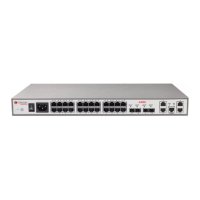A10E/A28E/A28F Configuration Guide
A commonly-used performance indicator of a telecommunication system
or channel. Depending on the specific system and service, it may relate
to jitter, delay, packet loss ratio, bit error ratio, and signal-to-noise ratio.
It functions to measure the quality of the transmission system and the
effectiveness of the services, as well as the capability of a service
provider to meet the demands of users.
Rapid
Spanning Tree
Protocol
(RSTP)
RSTP is an extension of Spanning Tree Protocol, which realizes quick
convergency of network topology.
Remote
Authentication
Dial In User
Service
(RADIUS)
A protocol used to authenticate and account users in the network.
Simple
Network
Management
Protocol
(SNMP)
A network management protocol defined by Internet Engineering Task
Force (IETF) used to manage devices in the Internet. SNMP can make
the network management system to remotely manage all network
devices that support SNMP, including monitoring network status,
modifying network device configurations, and receiving network event
alarms. At present, SNMP is the most widely-used network management
protocol in the TCP/IP network.
Simple
Network Time
Protocol
(SNTP)
SNTP is mainly used for synchronizing time of devices in the network.
Only a single mode can be transmitted in one fiber.
Spanning Tree
Protocol
(STP)
STP can be used to eliminate network loops and back up link data. It
blocks loops in logic to prevent broadcast storms. When the unblocked
link fails, the blocked link is re-activated to act as the protection link.
Virtual Local
Area Network
(VLAN)
VLAN is a protocol proposed to solve broadcast and security issues for
Ethernet. It divides devices in a LAN into different segment logically
rather than physically, thus implementing virtual work groups which are
based on Layer 2 isolation and do not affect each other.

